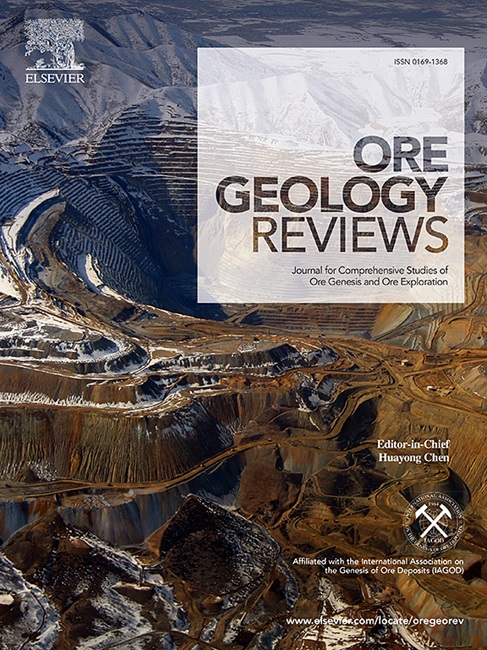Geology, pressure-temperature-composition conditions of hydrothermal fluids, and metallogenesis of the Late Jurassic Mahe and Matoushan Mo deposits in the North Qinling terrane, Central China
IF 3.2
2区 地球科学
Q1 GEOLOGY
引用次数: 0
Abstract
The Mahe and Matoushan Mo deposits, as representatives in the North Qinling terrane, are insufficiently understood in terms of their geology, mineralization ages, fluid systems, and metallogenesis. Molybdenum mineralization at Mahe and Matoushan primarily occurs as veins and veinlets within the quartz schist of the Meso-Neoproterozoic Sichakou Formation and actinolite schist of the Meso-Neoproterozoic Guangdongping Formation, respectively. The metallogenic processes can be categorized into three stages: quartz-molybdenite veins (stage Ⅰ), quartz-molybdenite-polymetallic sulfide veins or veinlets (stage Ⅱ), and calcite-quartz ± fluorite veins (stage Ⅲ). Four predominate inclusion types are identified, including the type 1 H2O-CO2-NaCl ± CH4 inclusions, type 2 CO2 ± CH4 inclusions, type 3 solid-bearing multiphase inclusions, and type 4 H2O-NaCl inclusions. Fluid inclusion studies show that initial mineralizing fluids of stage Ⅰ are medium to high temperature (peaking at ca. 240–340°C), low to medium salinity (2.2–14.8 wt% NaCl eqv.), medium density (0.747–0.993 g/cm3), relatively oxidized, and CO2-rich (XCO2 = 0.04–0.39) H2O-CO2-NaCl systems, formed at about 73–222 MPa (corresponding to a paleodepth of 7.3–8.2 km). The main ore-forming fluids of stage Ⅱ are featured by medium to high temperature (peaking at ca. 240–380°C), low to high salinity (2.4–45.7 wt% NaCl eqv.), medium to high density (0.713–1.189 g/cm3), reduced, and CO2-rich (XCO2 = 0.03–0.76) H2O-CO2-NaCl ± CH4 systems. The estimated trapping pressures at Mahe and Matoushan are 69–208 MPa and 133–262 MPa, respectively, while the corresponding mineralization paleodepths are 6.9–7.7 km and ∼ 9.7 km. The stage Ⅲ barren fluids are defined as low temperature (peaking at ca. 140–180°C), low salinity (0.4–2.2 wt% NaCl eqv.), medium density (0.832–0.940 g/cm3), and CO2-poor-H2O-NaCl systems. Isotopic analyses of H, O, and C in quartz and calcite reveal that the metallogenic fluids of stage Ⅰ and Ⅱ were mainly from magmatic water, with massive meteoric water mixing at shallow crustal levels during stage Ⅲ. Sulfide S and Pb isotopes indicate that the metallic components predominantly originated from Late Jurassic granitoids. Immiscibility (phase separation) and remarkable transitions in redox state (from oxidized to reduced) and pH (from alkaline to acidic) of fluid systems were key factors for Mo precipitation. Molybdenite Re–Os dating provided the Late Jurassic isochron ages of 145.3 ± 3.7 Ma and 147.7 ± 4.7 Ma for Mahe and Matoushan, respectively, suggesting a post-collisional tectonic regime. Compared to porphyry Mo systems globally, the Mahe and Matoushan Mo deposits are classified as collision-type porphyry deposits, differing from rift- and subduction-related systems.

求助全文
约1分钟内获得全文
求助全文
来源期刊

Ore Geology Reviews
地学-地质学
CiteScore
6.50
自引率
27.30%
发文量
546
审稿时长
22.9 weeks
期刊介绍:
Ore Geology Reviews aims to familiarize all earth scientists with recent advances in a number of interconnected disciplines related to the study of, and search for, ore deposits. The reviews range from brief to longer contributions, but the journal preferentially publishes manuscripts that fill the niche between the commonly shorter journal articles and the comprehensive book coverages, and thus has a special appeal to many authors and readers.
 求助内容:
求助内容: 应助结果提醒方式:
应助结果提醒方式:


